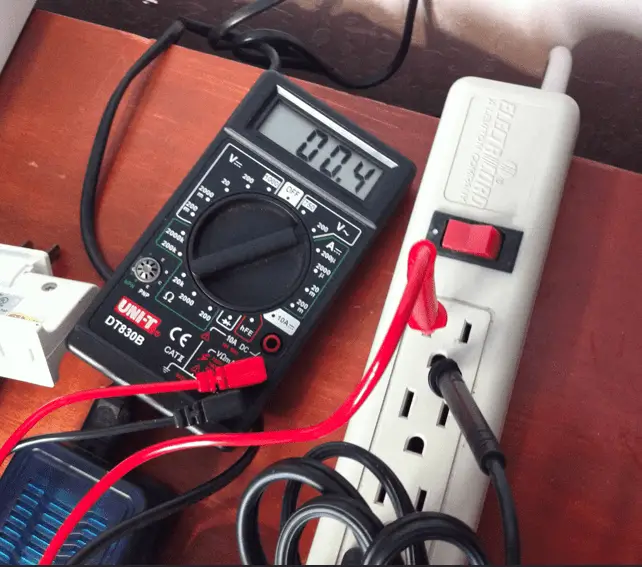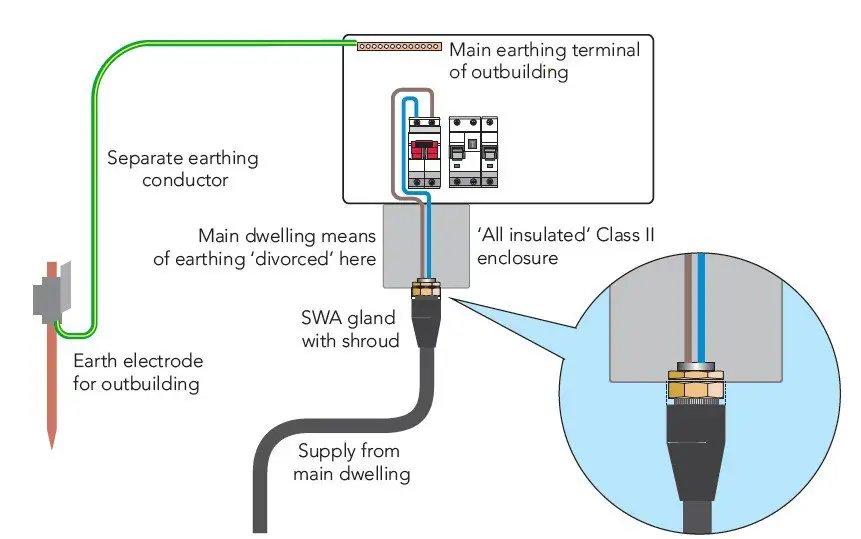
Ideally, the voltage measured across the neutral and the earth/ground must be zero. But sometimes there exists some measure of potential difference between them. Here, in this article let us analyze the causes of neutral to earth/ground voltage, its effect, and how to mitigate it.
Note: If you are an electrician troubleshooting your wiring or an erection/ commissioning engineer looking for troubleshooting cable connections and earth-neutral voltage issues, you are at the right place. We have a solution for you.
Modern domestic power sockets consist of line, neutral, and earth connections. The picture shows a multi meter reading the neutral to earth voltage. It can be seen that there is a minute voltage of 0.4V across them. This voltage is very little to cause any adverse effect.
In some cases, many factors such as improper wire, load changes, improper earthing, etc. raise the potential difference between the neutral and the earth. Such factors must be traced and fixed for the proper and safe operation of the equipment and the operator.
What is the acceptable voltage level between neutral and earthing?
Ideally the neutral to earth must be less than neutral to earth 0V. Neutral is earthed at the transformer end. It could be possible that at the load end, some amount of voltage may present, depending on how far the neutral earthing is, how much load is connected the system, presence of power electronic devices that induces harmonics to the system and the load distribution across the three phases. It is recommended to maintain it below 3V.
Causes of neutral to earth voltages
If your multi-meter indicates a neutral to ground voltage, that could be due to any one of the following causes:
- Improper earthing, caused due to loose earthing rods, wire breaks, or corrosion.
- Improper earth pits.
- If you measure 120V or 230V across the neutral and the earth and 0V between the line and the earth then the line and the neutral wires have been reversed.
- Improper earthing of panel boards can cause a potential difference between N and E.
- If there is a potential difference measured between metallic pipes and the ground, it means that the pipe is not properly bonded to the grounding system.
- Cable insulation damages.
- In a three-phase system with neutral, imbalance loading can cause neutral voltages. Unbalanced loads may cause heavy neutral currents.
- Short circuits.
- The line to ground faults.
- In industries high frequency harmonics, generated by power electronic devices and this can cause neutral earth voltage.
- Insulation failures and poor body panel earthing.
Effects of neutral to earth voltages
Neutral to earth voltage can be either due to improper wiring or due to improper earthing. In most cases, these voltages do not have any considerable effect on the system if the measured voltage to very small. It might have some effect on the electronic circuits but might not affect some others. Below are the few effects of neutral to earth voltages.
- Neutral voltage due to wrong wiring shall be higher and poses a risk of electrocution.
- Malfunctioning of electronic devices.
- Small neutral to earth voltages can light up LED lights even when switched off.
- Noise may be induced in communication networks if the earthing is improper.
- Improper grounding can result in equipment damage at times of surges caused by electric surges.
The solution to neutral to ground voltage problems
The solution to neutral to earth voltage issues begins with diagnosing the cause. Ultimately, there can be only two reasons: improper wiring and improper or lack of earth. Once the cause is traced, the problem can be solved. Here are a few steps to fix the issue:
For residential connections:
Step 1: Find a licensed electrician who can trace the cause.
Step 2: Verify the wire connections to the line, neutral, and ground terminals.
Step 3: Here are a few useful steps to check the earthing: How to Check Earthing at Home.
Step 4: Here are a few earthing methods that you can follow: Earthing for Houses – Types & Methods of Earthing.
Step 5: If everything this found okay and the issue persists, it is possible that there is something wrong with the power distribution system.
Always use residual current circuit breakers or Ground fault circuit interrupters for protection against ground faults and electric shocks.
For industrial connections:
If you are engineer or an electrician, you might already know how to diagnose earth faults and fix them. Below are a few additional things that might need your attention.
- Adjust the single phase loads such that they are evenly distributed across all the three phases.
- Make sure all equipment are properly bonded.
- Make sure that there is no insulation failures in the system.
- Make sure that the cable terminations at the panel board is proper and the gland plate is properly connected to the earth.
- Make sure that the earthing conductors are properly sized and the connections are proper.
- Use multiple rods for earthing can provide a parallel path for current flow and improve the earth connection.
- Make sure that proper power factor compensation is done.
- Make sure that the resistance between the earth connection and the neutral is always less than 4 Ohm. Higher resistance means poor neutral earthing.
- Make use of earth leakage relay, Core balance transformers and other residual current devices to detect earth fault.


good. improve my knowledge and very useful thanks for ur information
I’ve got 120v from line to earth ground, 0 volts from C to earth ground and 43v from house ground to earth ground. All wiring is fairly new and installed correctly. The refrigerator has a factory installed inverter w/ground for the compressor plus the unit itself is grounded. As the 43v fluctuates down to 9v. I’m wondering if this inverter acts like a French ground separate from the unit ground creating this?
Deadly. Get an electrician in before it kills you or your family.
I have got 400v distribution system and the Neutral and Ground voltage is 5.7v !
How can I reduce it less
Good knowledge of earthing it’s use full of industry.